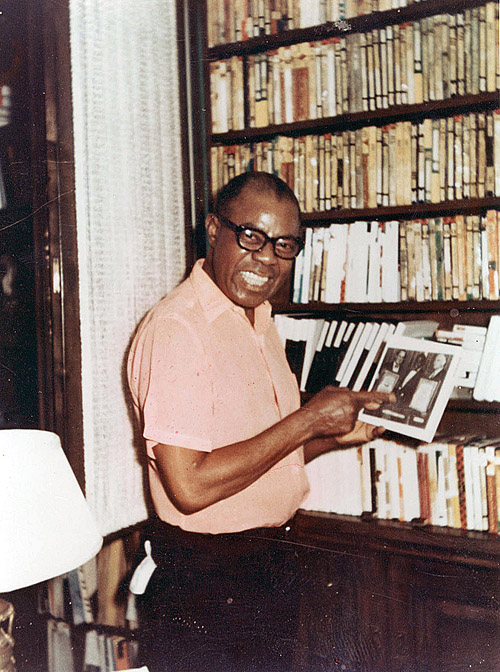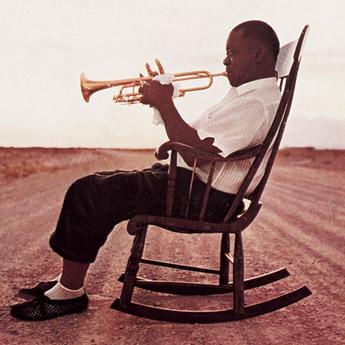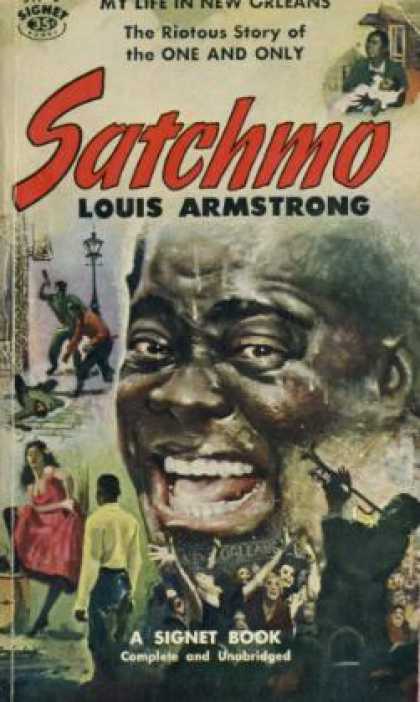 I’ve been keeping an amused eye on the books, CD, and DVDs purchased by people who order an advance copy of Pops: A Life of Louis Armstrong from Amazon. Some, like The Skeptic, Gary Giddins’ Satchmo, and Robin Kelley’s new biography of Thelonious Monk, seem reasonably plausible. Others are…well, less so.
I’ve been keeping an amused eye on the books, CD, and DVDs purchased by people who order an advance copy of Pops: A Life of Louis Armstrong from Amazon. Some, like The Skeptic, Gary Giddins’ Satchmo, and Robin Kelley’s new biography of Thelonious Monk, seem reasonably plausible. Others are…well, less so.
Here are some of the items that have been paired with Pops on Amazon’s “Customers Who Bought This Item Also Bought” module:
• Brian Kellow’s Ethel Merman: A Life
• Bob Dylan’s Christmas in the Heart
• Kate Summerscale’s The Suspicions of Mr. Whicher: A Shocking Murder and the Undoing of a Great Victorian Detective
• Douglas G. Brinkley’s The Wilderness Warrior: Theodore Roosevelt and the Crusade for America
• Dave Eggers’ Zeitoun
• The Joan Crawford Collection, Vol. 2
• William Maxwell: Early Novels and Stories
• Michael Burleigh’s Blood and Rage: A Cultural History of Terrorism
• Drew Gilpin Faust’s This Republic of Suffering: Death and the American Civil War
• The Letters of Noël Coward
And here’s the weirdest co-purchase of all:
• James Wood’s How Fiction Works
Archives for November 2009
TT: Still more exciting Pops-related news
Amazon.com has chosen Pops as one of the ten best biographies of 2009.
To see the full list, go here.
TT: Almanac
“The canvas had that overly stunning, almost meretricious, quality of originals. The attention they call to themselves as such, to the oils laid on by a vanished hand, overcharge the aesthetic experience for the viewer, who oftener sees a fetish than a picture.”
Peter De Vries, The Blood of the Lamb
TT: Mondays aren’t so bad
Publishers Weekly just picked Pops: A Life of Louis Armstrong as one of the best books of 2009.
Says PW: “Teachout’s forceful reassertion of Louis Armstrong’s significance to 20th-century America is a model for writing serious biography about pop culture icons.”
To see the complete list, go here.
TT: Real and right
 Harcourt sent me the first finished copy of Pops: A Life of Louis Armstrong last Tuesday. It was an inordinately busy week crammed full of shows and deadlines, but I talked a sympathetic editor into giving me the rest of the day off and spent the afternoon and evening rereading the book. I spent a certain amount of time admiring the index, snuffling for typos–in vain, I’m glad to report–and confirming that the corrections I made on the galley proofs were incorporated into the final version. Mostly, though, I just flipped through the pages of Pops and marveled at how good it looked.
Harcourt sent me the first finished copy of Pops: A Life of Louis Armstrong last Tuesday. It was an inordinately busy week crammed full of shows and deadlines, but I talked a sympathetic editor into giving me the rest of the day off and spent the afternoon and evening rereading the book. I spent a certain amount of time admiring the index, snuffling for typos–in vain, I’m glad to report–and confirming that the corrections I made on the galley proofs were incorporated into the final version. Mostly, though, I just flipped through the pages of Pops and marveled at how good it looked.
Regular readers of this blog know that I believe the printed book to be well on its way to ultimate extinction. As I put it in a “Sightings” column written in 2006, a year before the introduction of the Kindle:
The printed book is a beautiful object, “elegant” in both the aesthetic and mathematical senses of the word, and its invention was a pivotal moment in the history of Western culture. But it is also a technology–a means, not an end. Like all technologies, it has a finite lifespan, and its time is almost up.
On the other hand, I have yet to buy a Kindle, and at the moment I have no plans to do so. This is partly because I prefer to wait until the kinks are ironed out (I’ve never been a truly early adopter) and partly because, like most middle-aged authors, I remain enamored of the sheer physicality of the old-fashioned printed book. I was intimately involved in the design of Pops–I even chose the typeface, as I have for all my books–and I think it might just be the best-looking book with which I’ve been involved. The dust jacket is gorgeous, the typography balanced and legible, the photos flawlessly reproduced, the paper pleasing to the touch. All these things add up to a total aesthetic experience that I find immensely gratifying. To put it another way, the printed version of Pops is both a vessel filled with interesting information and an objet d’art that is beautiful in its own right.
 So am I really a closet Luddite, a technological Moses who can’t bring himself to enter the promised land of the e-book? Maybe. Six years ago I declared myself to be “open, at least in theory, to the possibility of abandoning the book-as-art-object.” Now that technology has finally caught up with me, I find myself unexpectedly unwilling to put my money where my mouth is. Yet I believe no less firmly than ever that the printed book is a technology whose time has come and gone. Am I, then, a hypocrite? Or merely a middle-aged man who, like most middle-aged men, is reluctant to put aside the youthful things that remind me of myself when young?
So am I really a closet Luddite, a technological Moses who can’t bring himself to enter the promised land of the e-book? Maybe. Six years ago I declared myself to be “open, at least in theory, to the possibility of abandoning the book-as-art-object.” Now that technology has finally caught up with me, I find myself unexpectedly unwilling to put my money where my mouth is. Yet I believe no less firmly than ever that the printed book is a technology whose time has come and gone. Am I, then, a hypocrite? Or merely a middle-aged man who, like most middle-aged men, is reluctant to put aside the youthful things that remind me of myself when young?
I hasten to point out that I no longer own any long-playing records or cassettes, and that I spend more time listening to music on my MacBook and iPod than on my CD player. No doubt the time will also come when I spend more time reading books on a Kindle, or something like it, than reading the handsomely bound volumes shelved in my living room. Not for me the self-conscious posturing of those curmudgeonly poseurs who wail Change and decay in all around I see! at every opportunity. Nor would I surprised if my next book, whatever it happens to be and whenever it happens to come out, is published solely in electronic form–yet I can’t imagine that the thrill I get from downloading the first “copy” will be half so intense as the one I got last week when I held the first finished copy of Pops in my hands.
TT: Almanac
“One dreams of the goddess Fame and winds up with the bitch Publicity.”
Peter De Vries, The Mackerel Plaza
FORTY YEARS OF CIVILISATION
“The notion of devoting a 13-hour TV series to the glories of Western art would now be thought comical–or contemptible–by those well-placed eggheads who regard the West as the source of all evil in the postmodern world. Among such enlightened folk, Civilisation is regarded as an embarrassing relic, painfully slow-moving and politically retrogressive…”
SATCHMO AND THE JEWS
“To visit the Armstrong house, which is now a museum, is to see how its proud owner achieved ‘everything he has struggled for in life.’ It was the outward symbol of the lessons in life that he learned from Mayann, his devoted mother–and from the Jews of New Orleans, who helped teach him to return love for hatred and seek salvation in work…”
